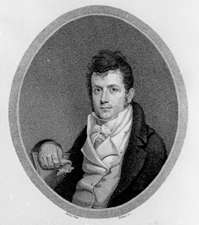Alexander Contee Hanson
| Alexander Contee Hanson | |
|---|---|
 | |
| United States Senator from Maryland | |
|
In office December 20, 1816 – April 23, 1819 | |
| Preceded by | Robert G. Harper |
| Succeeded by | William Pinkney |
| Member of the U.S. House of Representatives from Maryland's 3rd district | |
|
In office March 4, 1813 – 1816 | |
| Preceded by | Philip B. Key |
| Succeeded by | George Peter |
| Member of the Maryland House of Delegates | |
|
In office 1811–1815 | |
| Personal details | |
| Born |
February 27, 1786 Annapolis, Maryland |
| Died |
April 23, 1819 (aged 33) Elkridge, Maryland |
| Political party | Federalist |
Alexander Contee Hanson (February 27, 1786 – April 23, 1819) was an American lawyer, publisher, and statesman. He represented the third district of Maryland in the U.S. House, and the state of Maryland in the U.S. Senate.
Hanson, the grandson of John Hanson and son of Alexander Contee Hanson, Sr., was born in Annapolis, Maryland, and attended local private schools. He graduated from St. John’s College in Annapolis in 1802. He proceeded to study law, was admitted to the bar, and commenced practice in Annapolis. He served as a member of the Maryland House of Delegates from 1811 to 1815.
Hanson established and edited the Federal Republican, an extreme Federalist newspaper, in Baltimore. On June 22, 1812, four days after the beginning of the War of 1812, a mob that was irritated by his articles denouncing the administration destroyed his office. On July 28, he reissued the paper from another building, where he was joined by a group of armed allies. When that building was besieged by a mob, Hanson and his group fired, killing two. On the morning of July 29, Hanson and his group surrendered to the militia and were escorted to jail. That evening, the mob stormed the jail, and Hanson was beaten and left for dead. James Lingan, a military officer who came to Hanson's defence, died as a result of the violence.[1] Hanson moved the paper to Georgetown, D.C., where he published it unmolested. Hanson later moved to Rockville, Maryland.
In 1812, Hanson was elected as a Federalist representing the third district to the Thirteenth and Fourteenth Congresses, serving from March 4, 1813 until his resignation in 1816. Hanson was elected a member of the American Antiquarian Society in 1815.[2] He was an unsuccessful candidate in 1816 for election to the Maryland House of Delegates, but was elected as a Federalist to the United States Senate to fill the vacancy caused by the resignation of Robert Goodloe Harper. He served as senator from December 20, 1816 until his own death on his estate "Belmont", near Elkridge, Maryland. He is interred in the family burial ground.
References
- ↑ Peters, James Edward (2000). Arlington National Cemetery, Shrine to America's Heroes. Woodbine House. ISBN 1-890627-14-3.
- ↑ American Antiquarian Society Members Directory
External links
- United States Congress. "Alexander Contee Hanson (id: H000176)". Biographical Directory of the United States Congress.
- Paul A. Gilje, "The Baltimore Riots of 1812 and the Breakdown of the Anglo-American Mob Tradition," Journal of Social History 13 (Summer 1980): 547-564.
- PBS Documentary on The War of 1812
| United States House of Representatives | ||
|---|---|---|
| Preceded by Philip Barton Key |
Member of the U.S. House of Representatives from Maryland's 3rd congressional district 1813–1816 |
Succeeded by George Peter |
| United States Senate | ||
| Preceded by Robert G. Harper |
U.S. Senator (Class 1) from Maryland 1816–1819 Served alongside: Robert H. Goldsborough, Edward Lloyd |
Succeeded by William Pinkney |
